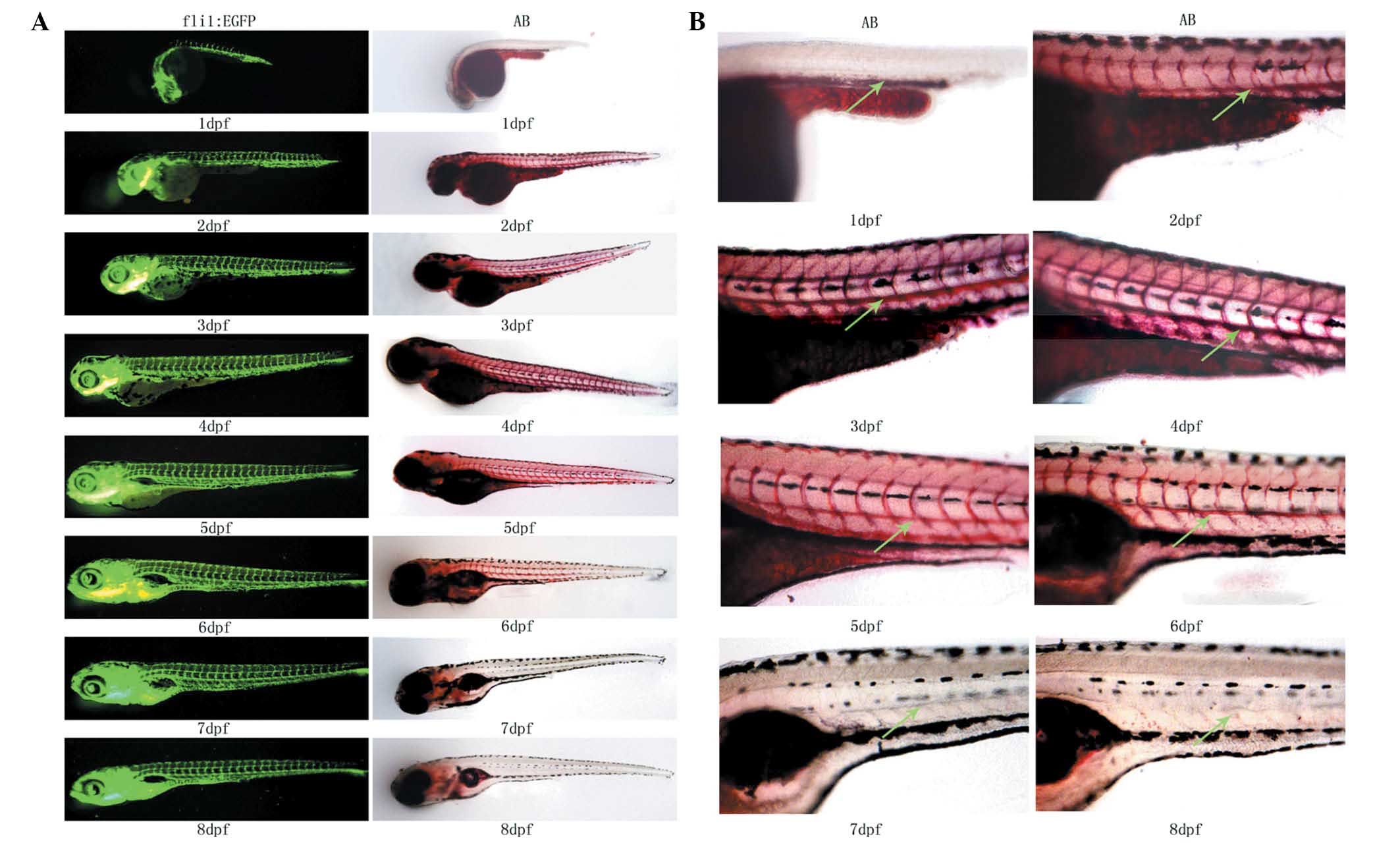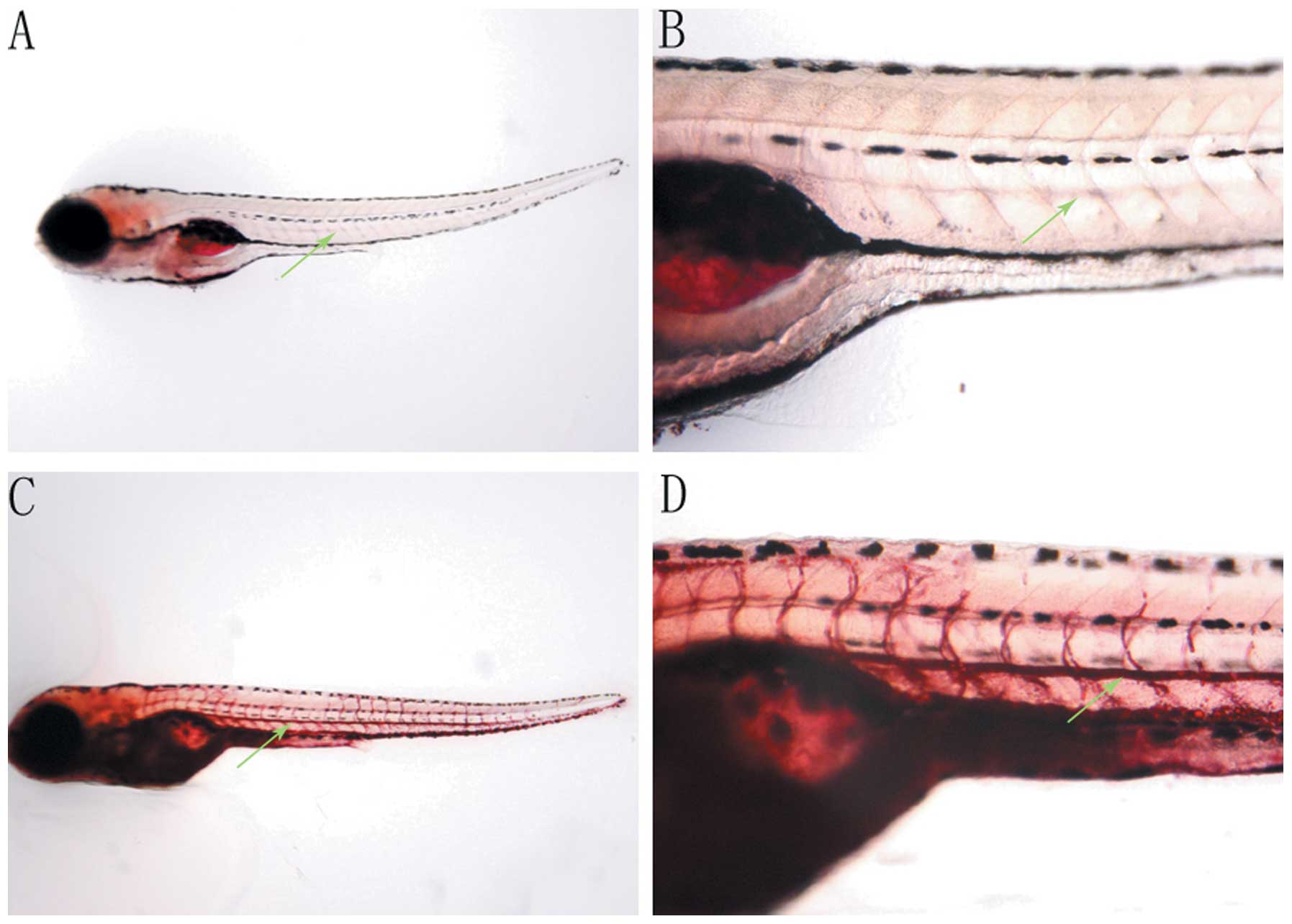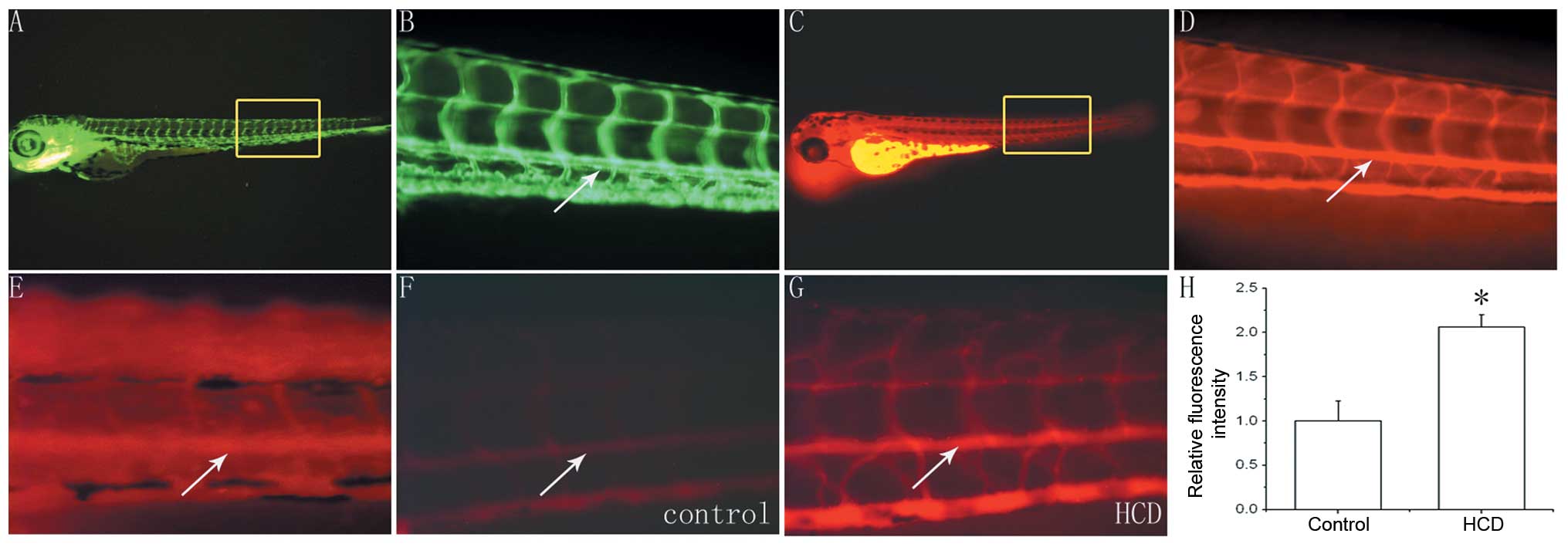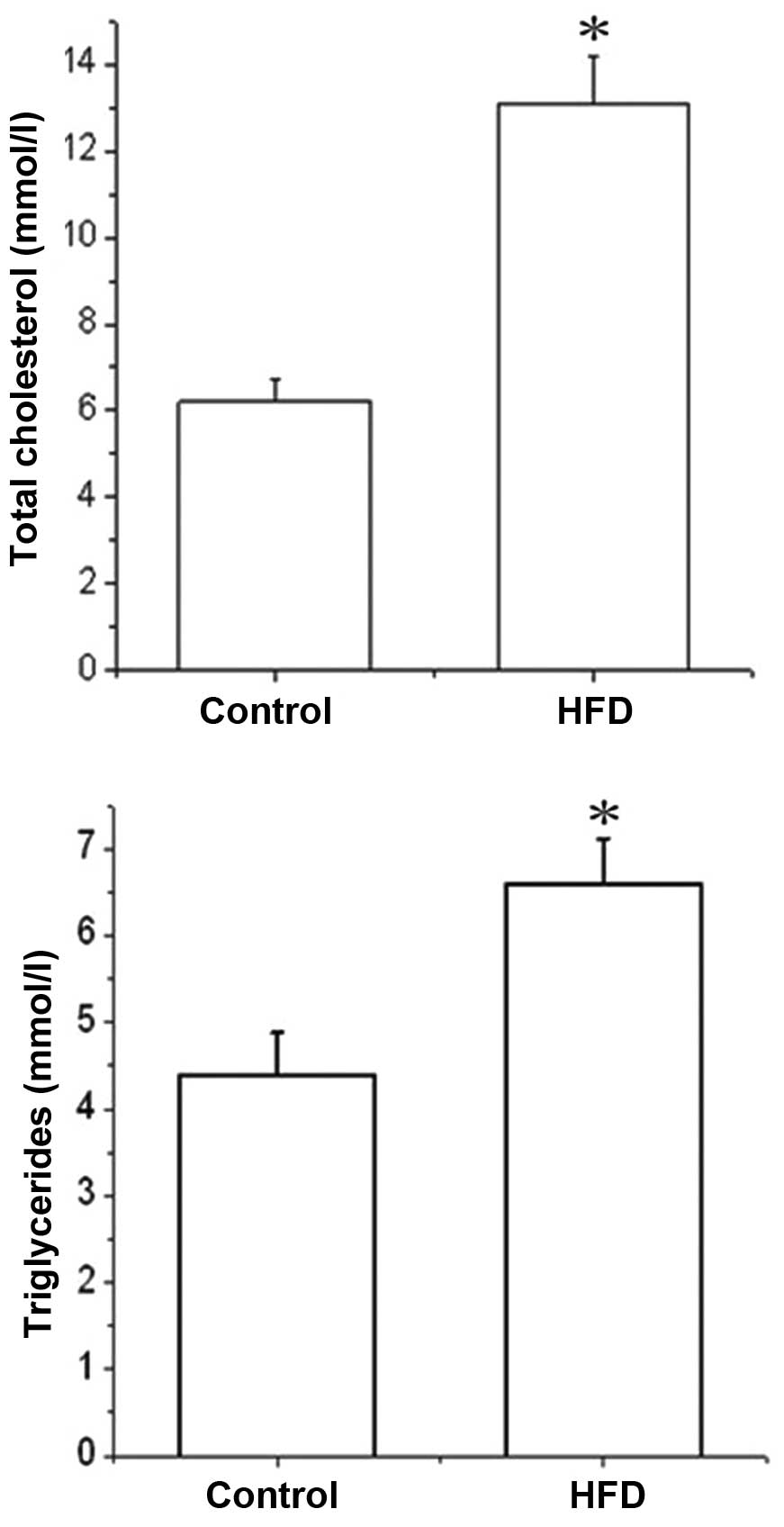|
1
|
Joffe BI, Panz VR and Raal FJ: From
lipodystrophy syndromes to diabetes mellitus (Review). Lancet.
357:1379–1381. 2001. View Article : Google Scholar : PubMed/NCBI
|
|
2
|
McNeely MJ, Edwards KL, Marcovina SM,
Brunzell JD, Motulsky AG and Austin MA: Lipoprotein and
apolipoprotein abnormalities in familial combined hyperlipidemia: a
20-year prospective study. Atherosclerosis. 159:471–481. 2001.
View Article : Google Scholar : PubMed/NCBI
|
|
3
|
Watanabe S, Yaginuma R, Ikejima K and
Miyazaki A: Liver diseases and metabolic syndrome (Review). J
Gastroenterol. 43:509–518. 2008. View Article : Google Scholar
|
|
4
|
Rocke J, Lees J, Packham I and Chico T:
The zebrafish as a novel tool for cardiovascular drug discovery
(Review). Recent Pat Cardiovasc Drug Discov. 4:1–5. 2009.
View Article : Google Scholar : PubMed/NCBI
|
|
5
|
Hölttä-Vuori M1, Salo VT, Nyberg L,
Brackmann C, Enejder A, Panula P and Ikonen E: Zebrafish: gaining
popularity in lipid research (Review). Biochem J. 429:235–242.
2010. View Article : Google Scholar
|
|
6
|
Schirmer H, Pereira TC, Rico EP, Rosemberg
DB, Bonan CD, Bogo MR and Souto AA: Modulatory effect of
resveratrol on SIRT1, SIRT3, SIRT4, PGC1α and NAMPT gene expression
profiles in wild-type adult zebrafish liver. Mol Biol Rep.
39:3281–3289. 2012. View Article : Google Scholar
|
|
7
|
Zhang Y, Hu G, Li S, Li ZH, Lam CO, Hong
SJ, Kwan YW, Chan SW, Leung GP and Lee SM: Pro-angiogenic activity
of astragaloside IV in HUVECs in vitro and zebrafish in vivo. Mol
Med Rep. 5:805–811. 2012.
|
|
8
|
Carten JD and Farber SA: A new model
system swims into focus: using the zebrafish to visualize
intestinal lipid metabolism in vivo. Clin Lipidol. 4:501–515. 2009.
View Article : Google Scholar
|
|
9
|
Hama K, Provost E, Baranowski TC,
Rubinstein AL, Anderson JL, Leach SD and Farber SA: In vivo imaging
of zebrafish digestive organ function using multiple quenched
fluorescent reporters. Am J Physiol Gastrointest Liver Physiol.
296:G445–G453. 2009. View Article : Google Scholar :
|
|
10
|
Farber SA, Pack M, Ho SY, Johnson ID,
Wagner DS, Dosch R, Mullins MC, Hendrickson HS, Hendrickson EK and
Halpern ME: Genetic analysis of digestive physiology using
fluorescent phospholipid reporters. Science. 292:1385–1388. 2001.
View Article : Google Scholar : PubMed/NCBI
|
|
11
|
Stoletov K, Fang L, Choi SH, Hartvigsen K,
Hansen LF, Hall C, Pattison J, Juliano J, Miller ER, Almazan F, et
al: Vascular lipid accumulation, lipoprotein oxidation, and
macrophage lipid uptake in hypercholesterolemic zebrafish. Cir Res.
104:952–960. 2009. View Article : Google Scholar
|
|
12
|
Kang OH, Kim SB, Seo YS, Joung DK, Mun SH,
Choi JG, Lee YM, Kang DG, Lee HS and Kwon DY: Curcumin decreases
oleic acid-induced lipid accumulation via AMPK phosphorylation in
hepatocarcinoma cells. Eur Rev Med Pharmacol Sci. 17:2578–2586.
2013.PubMed/NCBI
|
|
13
|
Schlegel A and Stainier DY: Microsomal
triglyceride transfer protein is required for yolk lipid
utilization and absorption of dietary lipids in zebrafish larvae.
Biochemistry. 45:15179–15187. 2006. View Article : Google Scholar : PubMed/NCBI
|
|
14
|
Marks DL, Bittman R and Pagano RE: Use of
Bodipy-labeled sphingolipid and cholesterol analogs to examine
membrane microdomains in cells. Histochem Cell Biol. 130:819–832.
2008. View Article : Google Scholar : PubMed/NCBI
|
|
15
|
Schlombs K, Wagner T and Scheel J: Site-1
protease is required for cartilage development in zebrafish. Proc
Natl Acad Sci USA. 100:14024–14029. 2003. View Article : Google Scholar : PubMed/NCBI
|
|
16
|
Murphey RD, Stern HM, Straub CT and Zon
LI: A chemical genetic screen for cell cycle inhibitors in
zebrafish embryos. Chem Biol Drug Des. 68:213–219. 2006. View Article : Google Scholar : PubMed/NCBI
|
|
17
|
Gosai SJ, Kwak JH, Luke CJ, Long OS, King
DE, Kovatch KJ, Johnston PA, Shun TY, Lazo JS, Perlmutter DH, et
al: Automated high-content live animal drug screening using C.
elegans expressing the aggregation prone serpin α1-antitrypsin Z.
PLoS One. 5:e154602010. View Article : Google Scholar
|
|
18
|
Wheeler GN and Brändli AW: Simple
vertebrate models for chemical genetics and drug discovery screens:
lessons from zebrafish and Xenopus. Dev Dyn. 238:1287–1308. 2009.
View Article : Google Scholar : PubMed/NCBI
|
|
19
|
Peterson RT, Link BA, Dowling JE and
Schreiber SL: Small molecule developmental screens reveal the logic
and timing of vertebrate development. Proc Natl Acad Sci USA.
97:12965–12969. 2000. View Article : Google Scholar : PubMed/NCBI
|
|
20
|
Lieschke GJ and Currie PD: Animal models
of human disease: zebrafish swim into view (Review). Nat Rev Genet.
8:353–367. 2007. View
Article : Google Scholar : PubMed/NCBI
|
|
21
|
Wallace KN, Akhter S, Smith EM, Lorent K
and Pack M: Intestinal growth and differentiation in zebrafish.
Mech Dev. 122:157–173. 2005. View Article : Google Scholar : PubMed/NCBI
|
|
22
|
Mehlem A, Hagberg CE, Muhl L, Eriksson U
and Falkevall A: Imaging of neutral lipids by oil red O for
analyzing the metabolic status in health and disease. Nat Protoc.
8:1149–1154. 2013. View Article : Google Scholar : PubMed/NCBI
|
|
23
|
Clifton JD, Lucumi E, Myers MC, Napper A,
Hama K, Farber SA, Smith AB III, Huryn DM, Diamond SL and Pack M:
Identification of novel inhibitors of dietary lipid absorption
using zebrafish. PLoS One. 5:e123862010. View Article : Google Scholar : PubMed/NCBI
|
|
24
|
Lawson ND and Weinstein BM: In vivo
imaging of embryonic vascular development using transgenic
zebrafish. Dev Biol. 248:307–318. 2002. View Article : Google Scholar : PubMed/NCBI
|
|
25
|
Terriente J and Pujades C: Use of
zebrafish embryos for small molecule screening related to cancer.
Dev Dyn. 242:97–107. 2013. View Article : Google Scholar
|
|
26
|
Brändli AW: Prospects for the Xenopus
embryo model in therapeutics technologies. CHIMIA. 58:694–702.
2004. View Article : Google Scholar
|
|
27
|
Chan J and Serluca FC: Chemical approaches
to angiogenesis. Methods Cell Biol. 76:475–487. 2004. View Article : Google Scholar : PubMed/NCBI
|
|
28
|
Starkuviene V and Pepperkok R: The
potential of high-content high-throughput microscopy in drug
discovery. Br J Pharmacol. 152:62–71. 2007. View Article : Google Scholar : PubMed/NCBI
|
|
29
|
Hong CC, Peterson QP, Hong J-Y and
Peterson RT: Artery/vein specification is governed by opposing
phosphatidylinositol-3 kinase and MAP kinase/ERK signaling. Curr
Biol. 16:1366–1372. 2006. View Article : Google Scholar : PubMed/NCBI
|
|
30
|
Peterson RT and Fishman MC: Discovery and
use of small molecules for probing biological processes in
zebrafish. Methods Cell Biol. 76:569–591. 2004. View Article : Google Scholar : PubMed/NCBI
|
|
31
|
Stern HM, Murphey RD, Shepard JL, Amatruda
JF, Straub CT, Pfaff KL, Weber G, Tallarico JA, King RW and Zon LI:
Small molecules that delay S phase suppress a zebrafish bmyb
mutant. Nat Chem Biol. 1:366–370. 2005. View Article : Google Scholar : PubMed/NCBI
|













